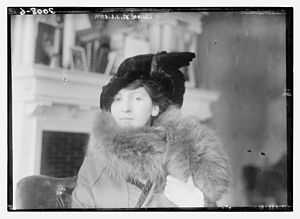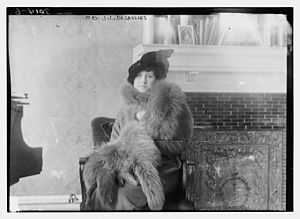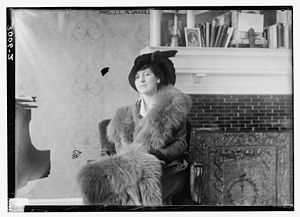Blanca Errázuriz




Blanca Elena Errázuriz Vergara (April 9, 1894 – March 20, 1940), also known as Bianca de Saulles was accused and later acquitted of murdering her first husband, John de Saulles.
Early life and marriage
Blanca Errázuriz was born in Viña del Mar, Chile, the eldest daughter of Guillermo Errázuriz Urmeneta and of Blanca Vergara Alvarez, a beauty known as the Star of Santiago, and thus a member of the politically influential Errázuriz family, of Basque descent. Her father, a mining magnate, died when she was two, and she was educated at Sacred Heart Convent in London, England. In 1911, when she was 16 years old, she met John Gerald Longer de Saulles, an American businessman and society figure 15 years her senior; he had travelled to Chile as representative of the South American Concessions Syndicate to negotiate a new railway line. After some initial difficulties with her family (mostly due to the difference in age and religion) they were soon engaged and on December 14, 1911 married at an English Catholic chapel[1] in Paris, France. (The civil ceremony had taken place the previous day.).[2]
De Saulles had previously been engaged to the heiresses Mary Elsie Moore (later Princess Torlonia) and Eleanor Granville Brown. He was later briefly appointed as U. S. Minister to Uruguay in 1914, a post he resigned shortly after accepting and without ever leaving the U.S.
The newly married couple settled in New York City. They had one child, John Longer de Saulles, who was born on December 25, 1912, and for whom the steel magnate Charles H. Schwab stood as godfather.
The divorce
In 1915 Blanca Errázuriz, by then unhappily married, befriended Rudolph Valentino in New York City, where he was working as an exhibition dancer (taxi dancer) and had gained attention for his rendition of the Argentine tango, which was the craze at the time. Whether the two actually had a romantic relationship is unknown, but Valentino did agree to provide proof in court during the de Saulles' divorce case that Joan Sawyer, his dancing partner, was having an adulterous relationship with John de Saulles; he himself took the stand to support Blanca's claim of John's infidelities. De Saulles was also accused of various financial improprieties involving his misuse of his wife's fortune, claims that received greater validity when it became clear upon his death that de Saulles was deeply in debt.[3]
John de Saulles was not pleased with this, and once the divorce was granted on December 1916,[4] he used his political connections to have Valentino arrested along with a madam named Mrs. Thyme (the exact charges are unknown). The evidence was flimsy at best (Valentino having been near the wrong place at the wrong time) and after a few days in jail, Valentino's bail was lowered from $10,000 to $1,500.[5] The scandal was well publicized along with the trial, and Valentino felt degraded and misused. No one would hire him, his old friends would no longer talk to him and Blanca seemed to not even thank him for his testimony.
The murder and trial

Shortly after the divorce was final, on August 3, 1917, Blanca had herself driven from her home in Roslyn, New York to the home of her ex-husband, The Box, in Meadowbrook Colony, near Westbury. She had legal claims over the custody of their son, since she and her husband had been given shared custody over him, but de Saulles refused to acknowledge the court's decision. She arrived at The Box shortly after 8 PM, and found her former husband sitting on the porch of the house. They argued, and she pointed a gun at his head demanding of him to immediately hand over the child to her. When he tried to disarm her, she shot him five times.[6] He was rushed to the Nassau County Hospital, but died there at 10:20 PM of his injuries.[7] In the meantime, she awaited at the house for the arrival of the police, to whom she surrendered. She was charged with murder in the first degree and imprisoned in the Nassau County Jail at Mineola, New York, leading to a sensational trial.[8]
The widely reported case went on for months. Blanca was defended by Henry Uterhart, a noted criminalist of the time, and the principal witness for the defense was Suzanne Monteau, Blanca's French maid, who had accompanied her that night and completely supported her version of the events.[9] Blanca Errázuriz became the darling of the press, and the champion of the suffragettes who portrayed her as the victim of the chauvinism prevalent in the society of the time,[10] while Valentino's name was again dragged through the mud though he had nothing to do with Blanca by this point.
Blanca Errázuriz was unanimously acquitted of the murder charges on December 1, 1917 in what was called a "popular" verdict.[11]
Aftermath and later life
Following the trial, Blanca Errázuriz moved first to San Francisco, California, where she sought and obtained full custody of her son, and later to Japan.[12] Eventually she and her son returned to Chile and settled there. On December 22, 1921 she remarried,[13] this time to Fernando Santa Cruz Wilson in Santiago; the couple later divorced.
Blanca Errazuriz lived until 1940, when she committed suicide in Viña del Mar.[14]
Legacy
The case was the basis for the 1918 silent movie The Woman and the Law, directed by Raoul Walsh. It featured Jack Connors, Miriam Cooper and Peggy Hopkins Joyce. (Guillermo Errázuriz, the diplomat brother of Blanca, killed himself in Paris in 1922, despondent over his love affair with Joyce.) The name "de Saulles" was changed to "La Salle" but the film's opening credits admit to being based on the story. Producer William Fox wanted Miriam Cooper to play in the film, as she so closely resembled the woman she was to portray. According to Cooper, people on the street would mistake her for Blanca de Saulles. Cooper fell ill when the film was to go into production, bowed out, and was replaced by another actress, who proved to be so terrible that Fox laid down the law with Cooper, telling her to make the film no matter how sick or how well she felt. It also helped that Raoul Walsh was her husband.
References
- ↑ The New York Times, December 14, 1911
- ↑ Cass City Chronicle, Cass City, Michigan, July 5, 1912
- ↑ "DESAULLES' FRIENDS DIVORCE ACCUSERS; Dancing Partner of Joan Sawyer and Manservant of Slain Man Gave Testimony. COOK ALSO A WITNESS District Attorney Says Evidence of Maid Will Be Strong Part of Murder Prosecution.", New York Times, 1917-08-12, retrieved 2008-08-10
- ↑ "LUTHERAN BOOK IS RUSHED.; Published In Seven Days to Answer Charges Against Reformer.". New York Times. 1916-12-20. Retrieved 2008-08-10.
- ↑ Leider, Emily W., Dark Lover: The life and death of Rudolph Valentino, p. 68-76
- ↑ "LITTLE SON SEES MRS. DE SAULLES; Mother's Depression Dispelled by Boy's Visit to Her in Jail. DE SAULLES WILL UNSIGNED Testament Outlines Plans for "Little Jack's" Future--Inquest Into Killing Begun. Waits With Arms Outstretched. Better Than Medicine. LITTLE SON SEES MRS.DE SAULLES Will Provided for Boy.". New York Times. 1917-08-10. Retrieved 2008-08-10.
- ↑ The New York Times, August 4, 1917
- ↑ Cass City Chronicle, Cass City, Michigan, August 24, 1917
- ↑ "DE SAULLES KILLING RE-ENACTED BY MAID; Suzanne Monteau Supports Theory That Mistress Acted on Sudden Impulse. TELLS OF PROVOCATION Says De Saulles's Looks Were Terrifying and He Declared MotherShould Never Have Boy.". New York Times. 1917-08-11. Retrieved 2008-08-10.
- ↑ "BROTHER DEFENDS DESAULLES' HONOR; Denounces Attack on Slain Man's Memory as "Grossly and Incredibly False." WIFE'S MONEY NOT MISUSED Prisoner, He Says, Agreed to the Division of Their Boy's Custody. MAY LET HER SEE HER LAD Uncle Promises to Do What He Thinks Father Would Have Done --Great Crowds at Funeral. Asks for Her Boys. Police Keep Crowd in Order.". New York Times. 1917-08-09. Retrieved 2008-08-10.
- ↑ "A "POPULAR" VERDICT.". New York Times. 1917-12-03. Retrieved 2008-08-10.
- ↑ "MRS. DE SAULLES IN JAPAN.; Accompanied by Her Son, She Has Taken a Villa Near Tokio.". New York Times. 1918-03-14. Retrieved 2008-08-10.
- ↑ "MRS. J.L. DE SAULLES WEDS AGAIN IN CHILE; Acquitted Slayer of Former Football Star Marries Fernando Santa Cruz Wilson.". New York Times. 1921-12-23. Retrieved 2008-08-10.
- ↑ "HEIRESS, ONCE WIFE OF J.L. DE SAULLES; Freed After Slaying Him, She Was Wed to F. de Santacruz". New York Times. 1940-03-22. Retrieved 2008-08-10.
External links
- Blanca Errázuriz at Flickr Commons
- "JOHN G. DE SAULLES TO WED IN PARIS; New Yorker's Marriage to Senorita Blanca Errazuriz to Take Place To-day or To-morrow.". New York Times. 1911-12-14. Retrieved 2008-08-10.
- Jack de Saulles' capture of Chili's richest beauty (July 5, 1912)
- "DE SAULLES IS SUED BY HIS CHILEAN WIFE; Former Yale Football Star and Friend of President Wilson Wed in 1911. TWO WOMEN ARE NAMED Fifth Avenue Real Estate Man Was Promoter in Chile When He Met the Heiress.". New York Times. 1916-07-28. Retrieved 2008-08-10.
- "JOHN L. DE SAULLES SLAIN IN HIS HOME BY FORMER WIFE; Neighbors Find Yale's Old Football Captain Dying fromFive Bullet Wounds.CHILEAN HEIRESS ARRESTEDQuarrel Over Custody of SonFollowed Her Divorce fromReal Estate Man. WANTED TO GET HER SON "I Am Glad I Did It," She Said,Because Father Had KeptBoy from Her. JOHN L. DE SAULLES SLAIN IN HIS HOME". New York Times. 1917-08-04. Retrieved 2008-08-10.
- "BROTHER DEFENDS DESAULLES' HONOR; Denounces Attack on Slain Man's Memory as "Grossly and Incredibly False." WIFE'S MONEY NOT MISUSED Prisoner, He Says, Agreed to the Division of Their Boy's Custody. MAY LET HER SEE HER LAD Uncle Promises to Do What He Thinks Father Would Have Done --Great Crowds at Funeral. Asks for Her Boys. Police Keep Crowd in Order.". New York Times. 1917-08-09. Retrieved 2008-08-10.
- "LITTLE SON SEES MRS. DE SAULLES; Mother's Depression Dispelled by Boy's Visit to Her in Jail. DE SAULLES WILL UNSIGNED Testament Outlines Plans for "Little Jack's" Future--Inquest Into Killing Begun. Waits With Arms Outstretched. Better Than Medicine. LITTLE SON SEES MRS.DE SAULLES Will Provided for Boy.". New York Times. 1917-08-10. Retrieved 2008-08-10.
- "DE SAULLES KILLING RE-ENACTED BY MAID; Suzanne Monteau Supports Theory That Mistress Acted on Sudden Impulse. TELLS OF PROVOCATION Says De Saulles's Looks Were Terrifying and He Declared MotherShould Never Have Boy.". New York Times. 1917-08-11. Retrieved 2008-08-10.
- "DESAULLES' FRIENDS DIVORCE ACCUSERS; Dancing Partner of Joan Sawyer and Manservant of Slain Man Gave Testimony. COOK ALSO A WITNESS District Attorney Says Evidence of Maid Will Be Strong Part of Murder Prosecution.". New York Times. 1917-08-12. Retrieved 2008-08-10.
- "INDICTS MRS. DE SAULLES.; Grand Jury Accuses Her of Murder In the First Degree.". New York Times. 1917-10-16. Retrieved 2008-08-10.
- "I DANCED, BUT NOT IN MY HEART, SAYS MRS. DE SAULLES; Wrote Gay Letters and Flattered Her Husband to KeepHim, She Testifies.STROVE TO HIDE DISTRESSState Reads Letters to ProveShe Was Not Low SpiritedWhen De Saulles Was Away. CROSS-EXAMINATION ENDS Story of $20,000 Ring for Mme.Errazuriz Brought Out--Nurses Take the Stand. Made Use of Woman's Wiles. Turns to British Slang. Finds Excuse for Juror. DANCE NOT IN HEART, MRS. DESAULLES SAYS Always Taking the Blame. The Joy of Living. Believed in Flattery. First Letter of the New Year. Thought Letter Rude. But She Liked the Clothes. The Actress's Picture.". New York Times. 1917-11-28. Retrieved 2008-08-10.
- "A "POPULAR" VERDICT.". New York Times. 1917-12-03. Retrieved 2008-08-10.
- Hansboro News newspaper for December 7, 1917
- Short biographical antecedents of Blanca Errázuriz (Spanish)
- Memories of the events (Spanish)
- Short biography and genealogical page (Spanish)
- "MRS. DE SAULLES IN JAPAN.; Accompanied by Her Son, She Has Taken a Villa Near Tokio.". New York Times. 1918-03-14. Retrieved 2008-08-10.
- "MRS. J.L. DE SAULLES WEDS AGAIN IN CHILE; Acquitted Slayer of Former Football Star Marries FernandoSanta Cruz Wilson.". New York Times. 1921-12-23. Retrieved 2008-08-10.
- The Woman and the Law at the Internet Movie Database